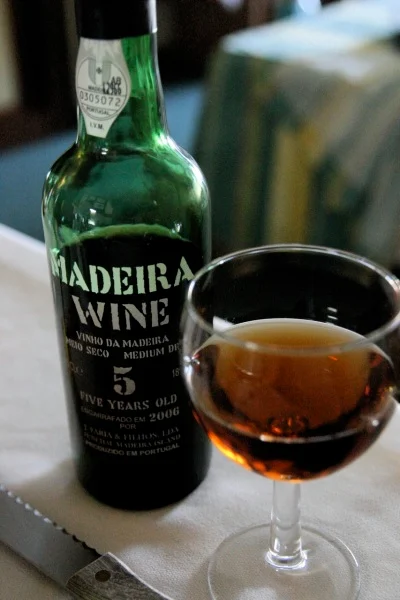Madeira is a captivating destination that offers both natural beauty and a celebrated wine, making it a unique and fascinating place and taste to explore.
Located 500 miles west of Morocco, Madeira is a Portuguese island situated in the Atlantic Ocean. Its stunning landscapes, including lush green mountains, dramatic cliffs, and picturesque coastal towns, have made it a popular holiday destination in Europe.
One of the most iconic aspects of Madeira is its wine, which shares its name with the island. Madeira wine has a rich history dating back to the 19th century, when it was considered a drink of the elite. The wealthy and discerning connoisseurs of the time sought out Madeira wine not only for its exquisite taste but also for its status and sophistication it represented.
Madeira wines are celebrated for their unique characteristics. They come in various styles, each with its own distinctive flavour profile. These wines are known for their rich colours, ranging from deep amber to golden hues, which are visually enticing.
The aromas of Madeira wines are equally alluring, with notes of dried fruits, caramel, nuts, and spices that create a complex bouquet. What truly sets Madeira wine apart is its exceptional longevity. Unlike many other wines, Madeira wine can age gracefully for decades, if not centuries, without losing its quality.
This remarkable longevity has made Madeira wine highly sought after by collectors and wine enthusiasts. In the 18th century, Madeira wine had a reputation vastly different from its contemporary status. During this period, it was commonly regarded as an affordable and unpretentious table wine.
It was produced using a base of white grape must, and to achieve the desired colour and flavour, vintners and exporters often added varying quantities of red must. A significant transformation took place during the transition from the 18th to the 19th century, a period marked by the signing of the Methuen Treaty (also known as the Port Wine Treaty) between England and Portugal.
This landmark agreement entailed Portugal committing to ending its prohibition on the importation of English woollen cloth, while England pledged to offer preferential treatment to Portuguese wines by imposing only two-thirds of the import tax that was applicable to French wines. This arrangement was to remain in force indefinitely. In the event that England failed to fulfil its promises, Portugal retained the option to reinstate the prohibition on the importation of English woollens.
In 1807, Britain took control of Madeira and this marked the beginning of Madeira wine as we know it, a product extolled by oenophiles. The evolution of Madeira wine was not the work of a solitary “genius.” Instead, it resulted from a collaborative effort involving an intricate Atlantic network of producers, distributors, and consumers engaged in lively discussions with one another.
This transformation was both an economic endeavour driven by commercial interests and a social phenomenon. Trans-Atlantic commerce played a pivotal role in this transformation, acting as an expansive and informal system. It was a dynamic process characterized by a continuous and sometimes bewildering exchange of information about various aspects of commodities.
This exchange encompassed details on how these commodities were produced, packaged, and shipped, as well as how they were distributed, stored, displayed, and ultimately consumed. Essentially, the Madeira wine that became highly regarded in subsequent centuries was the product of a multifaceted and collaborative effort, shaped by the interactions and conversations of individuals on both sides of the Atlantic. It was a testament to the power of shared knowledge, innovation, and the evolving tastes of the time, transforming Madeira from a humble table wine into a celebrated and iconic beverage.
Madeira’s climate, with its hot summers and mild winters, plays a crucial role in the maturation process of the wine. The wine is aged in oak barrels and subjected to a unique heating and cooling process known as estufagem, which imparts the distinct flavours and character that make Madeira wine famous.
Madeira wine production is a source of pride for the region, and it remains the prized product of the island, with the vineyard cultivation carefully managed to ensure the production of high-quality grapes that are used in crafting this exceptional wine. The vineyards are often perched on steep slopes, making viticulture labour-intensive but rewarding.
Madeira wine production is a complex and intricate process that has been refined over centuries and it has earned international acclaim for its distinct flavours and exceptional longevity.
1. Grape Varieties: Madeira wine is made from a variety of grape types, each contributing its own distinct characteristics to the final product. The primary grape varieties used in wine production include Sercial, Verdelho, Bual (or Boal), and Malvasia (also known as Malmsey). Each grape variety is associated with a different style of Madeira wine, ranging from dry to sweet.
2. Soil: The soils are of volcanic origin, fertile, and very rich in organic matter.
3. Vineyard Cultivation: The vineyards in Madeira are often terraced on steep slopes to maximize sun exposure. The island’s volcanic soil, combined with its unique climate, plays a crucial role in grape cultivation.
4. Harvesting: Grapes are harvested by hand, typically in late summer or early autumn, when they have reached the desired level of ripeness. The timing of the harvest can vary depending on the intended style of Madeira wine.
5. Grape Crushing: After harvest, the grapes are crushed, and the juice, known as “must,” is extracted. The must is collected in fermentation tanks for further processing.
6. Fermentation: In the past, Madeira wine was often fermented in wooden barrels. However, modern practices usually involve stainless steel tanks. The fermentation process can be stopped at various stages to achieve different levels of sweetness or dryness in the final wine.
7. Fortification: Once the desired level of sweetness is achieved, the fermentation is halted by adding grape spirits or brandy. This process stops the yeast from converting all the grape sugars into alcohol, preserving the wine’s sweetness.
8. Aging: Madeira wine is aged in oak barrels, often in a warm and humid environment, which accelerates the maturation process. The wine is subjected to a unique heating and cooling process called “estufagem,” which involves heating the wine and then allowing it to cool. This process contributes to the distinctive flavours and character of Madeira wine.
9. Blending: Blending is a crucial step in Madeira wine production, as it allows winemakers to create consistent and well-balanced wines. Different vintages and grape varieties may be blended to achieve the desired flavour profiles.
10. Categorization: Madeira wines are categorized based on their grape variety and sweetness level. The four main styles are Sercial (dry), Verdelho (medium-dry), Bual (medium-sweet), and Malvasia (sweet).
11. Bottling and Aging: After blending and categorization, Madeira wine is typically aged further in bottles, allowing it to mellow and develop complexity. Madeira wine is known for its exceptional aging potential, and some bottles can be aged for decades or even centuries.
12. Designation of Origin: Includes 450 hectares of vineyards, where the prominent grape variety, responsible for more than 80% of the total vineyard population, is Tinta Negra. The other fine grape varieties are all white: Sercial, Verdelho, Boal, and Malvasia.
13. Export: Started in the 18th century, Madeira was popular in most European courts, mainly England, France and the USA. In one of Shakespeare’s timeless plays, King Henry IV, the unforgettable character, Falstaff, is humorously accused of bartering his soul for a succulent chicken leg and a fine glass of Madeira wine.
Madeira was a preferred beverage among American colonists in the 18th century. It was consumed during the signing of the Declaration of Independence (1776). John Hancock, one of the signers, was known for his love of Madeira and is said to have toasted with it after putting his signature on the historic document. George Washington, the first President of the US, had a penchant for it.
He is known to have imported and consumed substantial quantities of Madeira, served it at Mount Vernon, his estate, and it was featured prominently in his social gatherings. In addition, it was frequently used in diplomacy and Thomas Jefferson, while serving as the American Minister to France, is known to have gifted bottles of Madeira wines to diplomats and officials, using it as a tool for diplomacy and relationship building.
Trade of Madeira was an important component of early American commerce. Merchants engaged in the importation and sale of Madeira contributed to the economic development of the young nation. While Madeira’s popularity in the US has fluctuated over the centuries, it remains a historical symbol of colonial and early American culture, representing both the refinement of the elite and the conviviality of the general populace.
Opinion:
1. Pereira D’Oliveira. Mavasia 1990
Oliveira proudly stands as the exclusive Madeira Wine company boasting a remarkable collection of Madeira Wine bottles and barrels dating back to the 1850s, all of which remain available for commercial purchase. Painstakingly crafted and adorned with intricate hand-painting in 2018, the 1990 Mavasia has matured gracefully within the hallowed confines of French oak barrels. These barrels find their sanctuary within the venerable 17th-century wine lodge nestled at the heart of historic Funchal.
A visual delight awaits as your eyes explore this wine, with its captivating hue of light caramel brown. The olfactory senses are treated to a harmonious symphony of aromas, with succulent raisins, honey, candied oranges, delicate spices, dried fruits, and a subtle trace of acidity weaving a captivating tapestry.
As the liquid touches your palate, it unfolds a symphony of flavours – nutty nuances, hints of ginger, the richness of maple syrup, the brightness of mandarin, and the zest of orange peel. With an impressive aging span of 20 years already, this exquisite Mavasia promises to endure for decades to come, a true testament to the enduring artistry of D’Oliverira.
2. H.M. Borges. Tinta Negra 2005 Sweet
Exclusively sourced from Tinta Negra grapes harvested on the picturesque slopes of Estreito de Camara de Lobos and the south coast of Madeira Island, H. M. Borges Madeira Wine undergoes a meticulous fermentation process that allows the tannins to gracefully dissolve while enabling the essential alcoholic fermentation. Crafted within the prestigious Demarcated Region of the Madeira Archipelago (PSR), this exquisite fortified wine boasts an alcohol content ranging from 17 to 22 percent, a testament to its robust character and opulent flavour profile.
Upon examination, this wine captivates with its alluring spectrum of colours, transitioning from a deep burnt caramel to a delightful beige infused with subtle hints of orange and yellow, creating an aesthetically pleasing visual experience. As you bring it to your nose, a symphony of enticing aromas unfolds, including the warm embrace of wood, the luscious sweetness of caramel, the golden allure of honey, and the toasted essence of almonds.
A discerning olfactory exploration will reveal notes of succulent figs, invigorating citrus, delicate honeysuckle, and a tantalizing hint of spice, all harmoniously interweaving their fragrant melodies. A subtle suggestion of marmalade adds depth and complexity to this aromatic journey, elevating the wine’s sensory allure.












